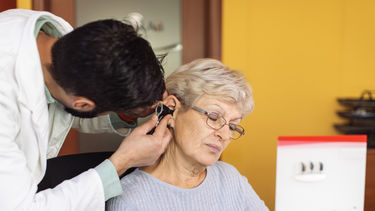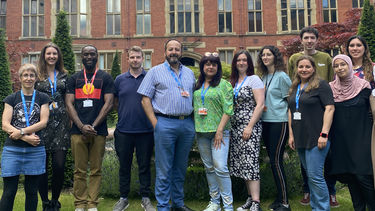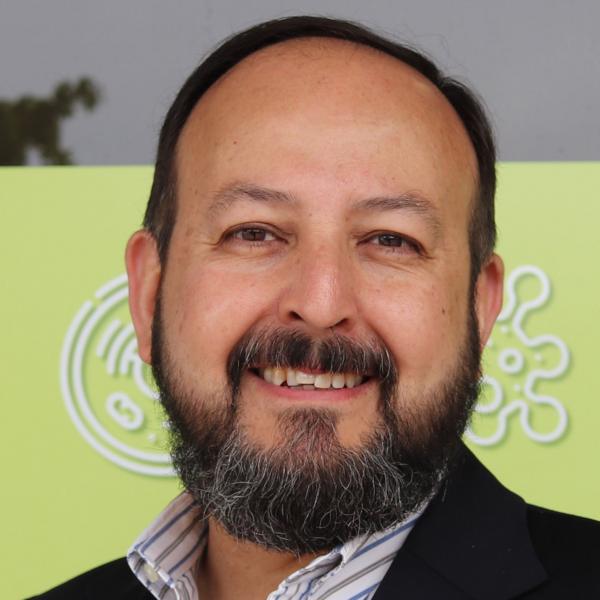On the verge of reversing deafness
A revolutionary approach to treating hearing loss is emerging. Sheffield researchers are developing novel cell therapies that could repair the damaged inner ear, potentially reversing deafness for many.

Hearing loss is a widespread issue affecting millions of people worldwide. It can significantly impact quality of life, leading to social isolation, depression, and even dementia.
Unfortunately, current treatments like hearing aids only manage the symptoms rather than addressing the root of the problem, as they do not repair the underlying causes of hearing loss.
The most common form of hearing loss globally is sensorineural (SNHL). This type of hearing loss is different from conductive hearing loss, which occurs when sound waves are prevented from reaching the inner ear due to a blockage in the outer or middle ear. SNHL is caused by age-related wear and tear, exposure to loud noise, certain medications, or underlying medical conditions.
SNHL occurs when the inner ear, the cochlea, is damaged. The cochlea is a spiral-shaped cavity filled with fluid containing the critical hearing cells. The primary hearing cells are the hair cells, which convert sound waves into electrical signals, and the cochlear neurons, which transfer this information to the brain via the auditory nerve. When these hair cells or their associated neurons are damaged, the brain cannot properly receive the sound signals, leading to hearing loss.
There is currently no cure or therapy for sensorineural hearing loss; the only treatments to manage the condition are hearing aids and cochlear implants. While these improve hearing for many people, they do not restore natural hearing or function for people with neural SNHL.
One of the biggest hurdles in developing effective hearing loss therapies is the loss of the inner ear cells' regenerative capacity. We are born with all the hearing cells to last a lifetime, and when these are damaged, they are lost forever, and we become deaf.
However, researchers at Sheffield are developing a breakthrough stem cell-based therapy to reverse SNHL that involves repairing the damaged inner ear with auditory stem cells.
Rinri Therapeutics
Rinri Therapeutics is a near-clinical-phase biotechnology company that originally spun out from work from Professor Rivolta’s group at the School of Biosciences at the University of Sheffield. Since its formation in 2018, the company has raised over £20 million from global investors, including Boehringer Ingelheim Venture Fund, UCB Ventures, Biocity and the UK Future Fund, as well as securing grants from Innovate UK and the MRC.
The company is now using Sheffield’s science to develop an allogeneic regenerative cell therapy, known as Rincell-1, to regenerate damaged auditory nerves in people with neural forms of SNHL.
This means that the therapy uses stem cells from a donor, not the patient themselves. The stem cells are then induced to generate Rincell-1, a progenitor cell that can be injected into the ear to become auditory nerve cells. These new cells are hoped to regenerate the damaged nerves and restore hearing.
Rinri Therapeutics is on the verge of a medical milestone, with plans to initiate the first human trial of Rincell-1 for hearing loss in 2025.
Understanding gene therapy and cell therapy
Recent advancements in gene and cell therapy offer significant hope for restoring hearing in patients with limited treatment options. Gene therapy is a molecular approach that seeks to correct faulty genetic code by introducing healthy gene sequences into a cell using a modified virus ‘vector’ as a carrier. A viral vector is a genetically engineered virus that is used to deliver genes into cells.
For these conditions, scientists can now replace defective genes, restore normal protein production, and reverse disease. This technique is particularly effective for conditions caused by a single gene mutation, such as certain inherited diseases. However, gene therapy is limited in its application when the underlying issue is the absence or loss of whole cells, tissues, or organs.
On the other hand, regenerative cell-based therapy seeks to replace dysfunctional cells to alleviate disease. It involves introducing stem cell-derived progenitor cells - cells with the ability to become specialised cell types - into the body. These progenitor cells can then differentiate into the cells needed to replace damaged or missing tissue. This approach is particularly promising for conditions like Parkinson's Disease, where neurons are lost, Macular Degeneration in the retina and tissue regeneration following musculoskeletal injuries.
A recent breakthrough in gene therapy has offered hope to those with a specific type of genetic hearing loss. Researchers from the US, UK, and China successfully treated patients with a mutation in the Otoferlin (OTOF) gene, which is crucial for auditory signal transmission between the inner hair cells and neurons in the cochlea. By delivering a healthy copy of the OTOF gene using a viral vector, scientists were able to restore hearing function in these patients.
The viral vector was first modified to remove its ability to cause illness, and then the healthy OTOF gene was inserted into it. The viral vector was then injected into the cochlea, which latched onto the surface of the inner hair cells and delivered the healthy OTOF gene. The healthy OTOF gene will then replace the mutated OTOF gene and start producing a healthy Otoferlin protein, restoring the communication between the hair cells and the neurons.
This achievement marks the first successful application of gene therapy for deafness, and it definitively shows that biological interventions can repair the damaged cochlea. While it is a significant step forward, it is important to note that this treatment is currently limited to patients with OTOF mutations which are quite rare. As each genetic form of deafness has its unique genetic causes, it will require a tailored gene therapy for each condition.
Most people with hearing loss do not have a genetic problem, so they will not benefit from gene therapies. However, cell therapies have the potential to treat many more people with SNHL which has been acquired over time through damage or simply through ageing.
Regenerative cell therapies
Researchers at Sheffield have been working on developing a breakthrough cell-based therapy to reverse SNHL. The therapy's concept is as simple as it is elegant. As the loss of hearing cells causes SNHL, the therapy will repair the damage by replacing them with new functional cells made from pluripotent stem cells. Pluripotent stem cells can produce any cell in the human body and are key to this groundbreaking research.
The technology uses the power of pluripotent stem cells, which can produce any cell in the human body. There are two main types: embryonic stem cells, derived from embryos, and induced pluripotent stem cells, created by reprogramming mature cells. Both types hold immense potential for regenerating damaged tissues, like those in the inner ear.
The initial research, funded by RNID and MRC, created cells that targeted the loss of cochlear neurons, for instance, in cases of auditory neuropathy, a specific type of hearing loss affecting the auditory nerve, which carries electrical signals from the inner ear to the brain. The loss of neurons is also a common feature in presbycusis, e.g., the loss of hearing produced by ageing.
These cochlear neurons generated from the stem cells were able to reverse hearing loss, resulting in a massive ~25dB cent improvement in the hearing threshold. If a similar effect could be replicated in humans, it would have an enormous clinical impact. In human terms, it could mean the difference between being unable to hear the traffic on the road and being able to maintain a conversation indoors.
Overcoming challenges
Rinri has successfully transitioned the cell production process from an academic setting to meeting the stringent demands of industrial manufacturing and is now focused on collecting essential safety data to meet regulatory standards.
"We're at a pivotal moment," says Marcelo Rivolta, "as we work to generate the necessary safety and efficacy data to initiate human clinical trials."
Furthermore, Rinri has surmounted the significant hurdle of delivery. Accessing the cochlea to deliver cell therapy is a complex challenge; the cells must go to the right place in the cochlea, so you cannot simply administer via a tablet or injection into the arm. The cochlea is deeply embedded within the petrous bone, one of the hardest bones in the human body. While cochlear implants have established surgical techniques for reaching this region, delivering cells to a specific location within the cochlea requires exacting precision.
To overcome this challenge, Rinri Therapeutics has collaborated with leading surgeons and imaging experts in an international, multicentre study to identify a novel access point. By utilising advanced imaging techniques, researchers have pinpointed a previously unexplored pathway that allows for safe and precise delivery of stem cells to the target area. This breakthrough in surgical approach is crucial for the successful implementation of cell-based therapies to the ear and represents a significant advancement in the field.
On the cusp of a breakthrough
Rinri Therapeutics is on track to begin First-In-Human trials of Rincell-1 in 2025, marking the world's first clinical trial for a cell therapy to treat hearing loss. These trials will target patients with severe hearing impairment due to auditory nerve damage. This innovative therapy could provide a transformative solution for millions living with hearing loss.
To proceed, Rinri Therapeutics must submit detailed documentation to regulatory authorities, including preclinical safety and efficacy data, clinical development protocols, patient eligibility criteria, treatment procedures, data collection methods, and safety monitoring plans. These documents will undergo rigorous review to ensure patient safety and scientific rigour. In preparation, the company has established partnerships with certified clinical sites capable of conducting the trials and recruiting eligible participants. Once regulatory approval is obtained, patient enrolment will begin, and the first phase of clinical testing can commence.
Looking ahead
Rinri Therapeutics envisions a future where its cell therapy becomes a standard of care for millions suffering from sensorineural hearing loss. While its immediate goal is to successfully complete human trials and establish proof of concept, its long-term vision is even more ambitious.
Rinri aims to evolve its technology into a widely accessible treatment that can transform lives.
Beyond neuron replacement, the company also plans to explore restoring cochlea hair cells and developing hypo-immune cell variants, potentially eliminating the need for immune suppression and broadening the therapy's reach and impact.
Our goal is to become a company that delivers life-changing solutions to millions of patients.
Professor Marcelo Rivolta
Professor of Sensory Stem Cell Biology in the School of Biosciences
Rinri’s pioneering research and innovative approach to accessing the inner ear offer renewed hope for individuals with hearing loss. With a robust preclinical dataset, the prospect of restoring hearing and improving the quality of life for millions is now within reach.
Written by Jack Dillon Carter, Digital Marketing Coordinator (Research)
For further information contact mediateam@sheffield.ac.uk




